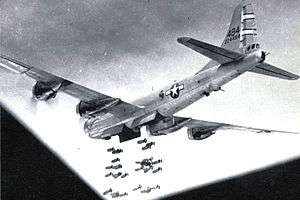795th Bombardment Squadron
The 795th Bombardment Squadron is a former United States Army Air Forces unit. The squadron was organized in 1943 as one of the first Boeing B-29 Superfortress units. After training in the United States, The squadron moved to India and participated in the strategic bombing campaign against Japan, earning a Distinguished Unit Citation before being disbanded on 12 October 1944 when the Army Air Forces reorganized its very heavy bomber groups to consist of only three squadrons.
| 795th Bombardment Squadron | |
|---|---|
 468th Bombardment Group B-29 Superfortress attacking a target on Formosa in October 1944[note 1] | |
| Active | 1943-1944 |
| Country | |
| Branch | |
| Role | strategic bombardment |
| Engagements | China Burma India Theater |
| Decorations | Distinguished Unit Citation |
History
Organization and training in the United States
The squadron was first organized at Smoky Hill Army Air Field, Kansas on 1 August 1943 as one of the four original squadrons of the 468th Bombardment Group. It was intended to be a Boeing B-29 Superfortress squadron, however due to the lack of B-29 availability, it was initially equipped with Boeing B-17 Flying Fortresses. The squadron completed its training and deployed from the United States to India in March 1944, flying across the South Atlantic and Africa to reach its combat station.[1][2]
Combat operations
The squadron arrived at Kharagpur Airfield, Bengal in mid-April. Its initial missions were transporting supplies and equipment to staging airfields in China, and it did not fly its first combat mission until 5 June, when it participated in a raid on railroad repair facilities near Bangkok, Thailand. Ten days later, it participated in the first attack on the Japanese Home Islands since the Doolittle Raid two years earlier.[2]
The unit staged through bases not only in China for attacks on Japan, but from other bases in India and Ceylon. It conducted mining operations off the coasts of French Indochina, near Saigon and China, near Shanghai. It attacked Japanese targets in Southeast Asia, including aircraft factories, naval installations, transportation facilities and iron works, and it flew sorties to targets as distant as Indonesia. In August 1944, the squadron struck a steel factory in Yawata, Japan, earning a Distinguished Unit Citation. In October 1944, the Army Air Forces reorganized its very heavy bombardment groups to have only three operational squadrons, and the 795th was disbanded.[1][2]
Lineage
- Constituted as the 792nd Bombardment Squadron (Heavy) on 19 May 1943
- Activated on 1 August 1943
- Redesignated 792nd Bombardment Squadron, Very Heavy on 20 November 1943
- Disbanded on 12 October 1944[1]
Assignments
- 468th Bombardment Group, 1 August 1943 – 12 October 1944[1]
Stations
- Smoky Hill Army Airfield, Kansas, 1 August 1943 – 12 March 1944
- Kharagpur Airfield, India, c. 13 April–12 October 1944[1]
Aircraft
- Boeing B-17 Flying Fortress, 1943
- Boeing B-29 Superfortress, 1943-1944[1]
Awards and campaigns
| Award streamer | Award | Dates | Notes |
|---|---|---|---|
| Distinguished Unit Citation | 20 August 1944 | Yawata, Japan[1] |
| Campaign Streamer | Campaign | Dates | Notes |
|---|---|---|---|
| India-Burma | c. 13 April 1944 – 12 October 1944 | [1] | |
| China Defensive | c. 13 April 1944 – 12 October 1944 | [1] | |
| Air Offensive, Japan | c. 13 April 1944 – 12 October 1944 | [1] |
See also
References
Notes
- Explanatory notes
- Aircraft is Boeing B-29-30-BW Superfortress, serial 42-24494, "Mary Ann" attacking with high-explosive bombs. This airplane overshot the runway due to propellor failure on 17 June 1945 at West Field, Tinian and was written off.
- Citations
- Maurer, Combat Squadrons, pp. 759-760
- Maurer, Combat Units, pp. 343-344
Bibliography
![]()
- Maurer, Maurer, ed. (1983) [1961]. Air Force Combat Units of World War II (PDF) (reprint ed.). Washington, DC: Office of Air Force History. ISBN 0-912799-02-1. LCCN 61060979. Retrieved 17 December 2016.
- Maurer, Maurer, ed. (1982) [1969]. Combat Squadrons of the Air Force, World War II (PDF) (reprint ed.). Washington, DC: Office of Air Force History. ISBN 0-405-12194-6. LCCN 70605402. OCLC 72556.
.png)
